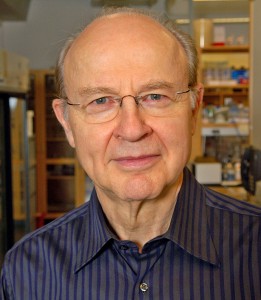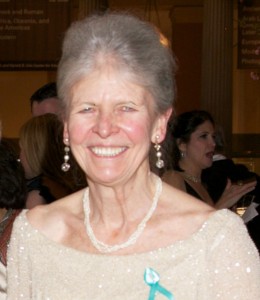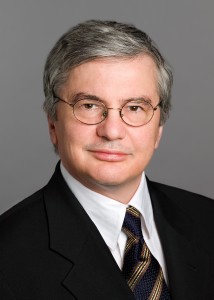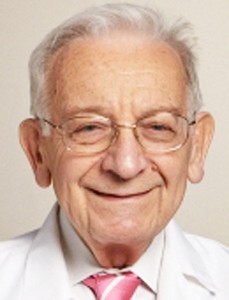2015 Honorees
Basic Science
Robert G. Roeder, Ph.D.
The Rockefeller University
 Dr. Roeder is the Arnold and Mabel Beckman Professor of Biochemistry and Molecular Biology at The Rockefeller University. He is a pioneer in eukaryotic transcription. Dr. Roeder was born in Boonville, Indiana. He received his B.A. summa cum laude in chemistry from Wabash College and his M.S. in chemistry from the University of Illinois. He received his Ph.D. in biochemistry in 1969 from the University of Washington, Seattle, where he worked with William J. Rutter. He did postdoctoral work with Donald D. Brown at the Carnegie Institution of Washington, in Baltimore, from 1969 to 1971. He was a member of the faculty at Washington University School of Medicine in St. Louis from 1971 to 1982, when he joined The Rockefeller University. In 1985, he was named Arnold and Mabel Beckman Professor. In 1969, Dr. Roeder made his initial groundbreaking discovery of the enzymes, called RNA polymerases, that directly read out and copy the messages encoded in DNA. He then identified these enzymes’ associated helper factors, collectively called the general transcription machinery; and subsequently defined the first of many hundreds of gene-specific DNA-binding regulatory proteins, called activators and repressors, that control the rate of gene transcription. In the late 1970s he developed cell-free systems to better study transcription, allowing researchers to recreate transcription in a test tube in a way that faithfully mimics the real process in cells. In the 1990s Dr. Roeder’s laboratory discovered the major conduit for direct communication between gene-specific activators and the general transcription machinery in animal cells: a giant co-activator complex that consists of about 25 different protein chains and is referred to as the human Mediator after its counterpart in yeast. Dr. Roeder’s work is now heavily focused on cofactors that act directly on the general transcription machinery, including a variety of activator- and cell-specific factors, and on an important new class of cofactors that alter the structure of the natural chromatin template. These cofactors are studied in the context of transcriptional activators (and corresponding genetic regulatory pathways) important for homeostasis (nuclear hormone receptors such as peroxisome proliferation-activated receptor and estrogen receptor), for tumor suppression (p53) and for certain blood cancers (leukemic fusion proteins). The Roeder laboratory continues to uncover novel mechanisms by which these co-activators, which he calls “multicomponent control panels,” integrate positive and negative regulatory signals, ultimately “deciding” whether to turn up or down a given gene’s expression or activity pattern. Dr. Roeder is a recipient of many awards that include the prestigious Albert Lasker Award for Basic Medical Research and the Gairdner Foundation International Award. He is a member of the National Academy of Sciences and the American Academy of Arts and Sciences.
Dr. Roeder is the Arnold and Mabel Beckman Professor of Biochemistry and Molecular Biology at The Rockefeller University. He is a pioneer in eukaryotic transcription. Dr. Roeder was born in Boonville, Indiana. He received his B.A. summa cum laude in chemistry from Wabash College and his M.S. in chemistry from the University of Illinois. He received his Ph.D. in biochemistry in 1969 from the University of Washington, Seattle, where he worked with William J. Rutter. He did postdoctoral work with Donald D. Brown at the Carnegie Institution of Washington, in Baltimore, from 1969 to 1971. He was a member of the faculty at Washington University School of Medicine in St. Louis from 1971 to 1982, when he joined The Rockefeller University. In 1985, he was named Arnold and Mabel Beckman Professor. In 1969, Dr. Roeder made his initial groundbreaking discovery of the enzymes, called RNA polymerases, that directly read out and copy the messages encoded in DNA. He then identified these enzymes’ associated helper factors, collectively called the general transcription machinery; and subsequently defined the first of many hundreds of gene-specific DNA-binding regulatory proteins, called activators and repressors, that control the rate of gene transcription. In the late 1970s he developed cell-free systems to better study transcription, allowing researchers to recreate transcription in a test tube in a way that faithfully mimics the real process in cells. In the 1990s Dr. Roeder’s laboratory discovered the major conduit for direct communication between gene-specific activators and the general transcription machinery in animal cells: a giant co-activator complex that consists of about 25 different protein chains and is referred to as the human Mediator after its counterpart in yeast. Dr. Roeder’s work is now heavily focused on cofactors that act directly on the general transcription machinery, including a variety of activator- and cell-specific factors, and on an important new class of cofactors that alter the structure of the natural chromatin template. These cofactors are studied in the context of transcriptional activators (and corresponding genetic regulatory pathways) important for homeostasis (nuclear hormone receptors such as peroxisome proliferation-activated receptor and estrogen receptor), for tumor suppression (p53) and for certain blood cancers (leukemic fusion proteins). The Roeder laboratory continues to uncover novel mechanisms by which these co-activators, which he calls “multicomponent control panels,” integrate positive and negative regulatory signals, ultimately “deciding” whether to turn up or down a given gene’s expression or activity pattern. Dr. Roeder is a recipient of many awards that include the prestigious Albert Lasker Award for Basic Medical Research and the Gairdner Foundation International Award. He is a member of the National Academy of Sciences and the American Academy of Arts and Sciences.
Robert Roeder’s Acceptance Remarks
Basic Science
Joan Elaine Argetsinger Steitz, Ph.D.
Yale University
 Dr. Steitz is Sterling Professor of Molecular Biophysics and Biochemistry at Yale University and Investigator at the Howard Hughes Medical Institute. She is known for her discoveries involving RNA. Joan received her Bachelor of Science degree in chemistry from Antioch College, Ohio and studied molecular biology in Alex Rich’s lab at Massachusetts Institute of Technology as an Antioch “coop” intern. She was accepted to Harvard Medical School, but having been excited by bench-science in the laboratory of Joseph Gall at the University of Minnesota, she declined the invitation to Harvard Medical School and instead applied to Harvard’s program in biochemistry and molecular biology. She was the first female graduate student to join the laboratory of James D. Watson. Dr. Steitz completed her postdoctoral research at the University of Cambridge (UK), where she collaborated with Francis Crick, Sydney Brenner, and Mark Bretscher. At Cambridge, Dr. Steitz discovered the exact sequences on mRNA at which bacterial ribosomes bind to produce proteins. In 1969 she published a seminal paper in Nature showing the nucleotide sequence of the bound start points. In 1970, Dr. Steitz joined the faculty at Yale. In 1975, she published the research for which she is widely known, demonstrating that ribosomes use complementary base pairing to identify the start sites on bacterial mRNA. Starting in 1979 with her MD/PhD student Michael Lerner, she identified novel cellular entities called snRNPs and defined their roles in splicing. Her later characterization of another kind of snRNP particle, snoRNPs, demonstrated conclusively that introns are not junk-DNA. Dr. Steitz has served in numerous professional capacities, including as scientific director of the Jane Coffin Childs Memorial Fund for Medical Research (1991–2002) and as editorial board member of Genes & Development. She has been honored with many awards, including the National Medal of Science, and membership in the National Academy of Sciences and the Royal Society of London (Foreign Member).
Dr. Steitz is Sterling Professor of Molecular Biophysics and Biochemistry at Yale University and Investigator at the Howard Hughes Medical Institute. She is known for her discoveries involving RNA. Joan received her Bachelor of Science degree in chemistry from Antioch College, Ohio and studied molecular biology in Alex Rich’s lab at Massachusetts Institute of Technology as an Antioch “coop” intern. She was accepted to Harvard Medical School, but having been excited by bench-science in the laboratory of Joseph Gall at the University of Minnesota, she declined the invitation to Harvard Medical School and instead applied to Harvard’s program in biochemistry and molecular biology. She was the first female graduate student to join the laboratory of James D. Watson. Dr. Steitz completed her postdoctoral research at the University of Cambridge (UK), where she collaborated with Francis Crick, Sydney Brenner, and Mark Bretscher. At Cambridge, Dr. Steitz discovered the exact sequences on mRNA at which bacterial ribosomes bind to produce proteins. In 1969 she published a seminal paper in Nature showing the nucleotide sequence of the bound start points. In 1970, Dr. Steitz joined the faculty at Yale. In 1975, she published the research for which she is widely known, demonstrating that ribosomes use complementary base pairing to identify the start sites on bacterial mRNA. Starting in 1979 with her MD/PhD student Michael Lerner, she identified novel cellular entities called snRNPs and defined their roles in splicing. Her later characterization of another kind of snRNP particle, snoRNPs, demonstrated conclusively that introns are not junk-DNA. Dr. Steitz has served in numerous professional capacities, including as scientific director of the Jane Coffin Childs Memorial Fund for Medical Research (1991–2002) and as editorial board member of Genes & Development. She has been honored with many awards, including the National Medal of Science, and membership in the National Academy of Sciences and the Royal Society of London (Foreign Member).
Joan Steitz’s Acceptance Remarks
Clinical Development
Napoleone Ferrara, M.D.
University of California San Diego
 Dr. Ferrara is a Distinguished Professor of Pathology at the University of California, San Diego. Dr. Ferrara received his medical degree from the Faculty of Medicine and Surgery at the University of Catania, Italy. He was postdoctoral Fellow at the University of California, San Francisco (UCSF). After his postdoctoral stage at UCSF, Dr. Ferrara worked at the leading biotechology company Genentech from 1988 – 2012. While at Genentech, he pioneered the development of new treatments for cancer and age-related macular degeneration. He discovered the angiogenic protein VEGF, and made the first VEGF antibody that suppresses growth of a variety of tumors. These findings led to development of the first clinically available anti-angiogenesis inhibitor drug, bevacizumab (Avastin), which prevents the growth of new blood vessels into a solid tumor and which has become part of standard treatment for a variety of cancers. Dr. Ferrara’s work led also to the development of ranibizumab (Lucentis), a drug that is highly effective at preventing vision loss in intraocular neovascular disorders. At UC San Diego Moores Cancer, Dr. Ferrara continues cancer drug research targeting angiogenesis. He is presently focusing on investigating mechanisms of tumor angiogenesis alternative to VEGF, in particular the role of factors produced by myeloid cells and fibroblasts in mediating resistance to VEGF inhibitors. Dr. Ferrara is a recipient of numerous scientific prizes including the Lasker Award, the Breakthrough Prize in Life Sciences and the Gairdner Foundation International Award. He is a member of the National Academy of Sciences.
Dr. Ferrara is a Distinguished Professor of Pathology at the University of California, San Diego. Dr. Ferrara received his medical degree from the Faculty of Medicine and Surgery at the University of Catania, Italy. He was postdoctoral Fellow at the University of California, San Francisco (UCSF). After his postdoctoral stage at UCSF, Dr. Ferrara worked at the leading biotechology company Genentech from 1988 – 2012. While at Genentech, he pioneered the development of new treatments for cancer and age-related macular degeneration. He discovered the angiogenic protein VEGF, and made the first VEGF antibody that suppresses growth of a variety of tumors. These findings led to development of the first clinically available anti-angiogenesis inhibitor drug, bevacizumab (Avastin), which prevents the growth of new blood vessels into a solid tumor and which has become part of standard treatment for a variety of cancers. Dr. Ferrara’s work led also to the development of ranibizumab (Lucentis), a drug that is highly effective at preventing vision loss in intraocular neovascular disorders. At UC San Diego Moores Cancer, Dr. Ferrara continues cancer drug research targeting angiogenesis. He is presently focusing on investigating mechanisms of tumor angiogenesis alternative to VEGF, in particular the role of factors produced by myeloid cells and fibroblasts in mediating resistance to VEGF inhibitors. Dr. Ferrara is a recipient of numerous scientific prizes including the Lasker Award, the Breakthrough Prize in Life Sciences and the Gairdner Foundation International Award. He is a member of the National Academy of Sciences.
Napoleone Ferrara’s Acceptance Remarks
Medicine
James F. Holland, M.D.
Mt. Sinai Medical School
 Dr. James Holland, a medical oncologist in New York City, is a Distinguished Professor of Neoplastic Diseases at Mount Sinai School of Medicine. Dr. Holland is a graduate of Princeton University and he received his medical degree from Columbia University College of Physicians and Surgeons. He is a pioneer in clinical cancer research, and his contributions to the field include his role at the National Cancer Institute in 1953. While at NCI, he and Emil Freireich, M.D., and Emil Frei III, M.D., were credited with first using combination chemotherapy in patients to successfully treat acute leukemia. Their work along with members of Acute Leukemia Group B on acute lymphoblastic leukemia in children resulted in its transformation from incurability to an over 80 percent survival rate. Dr. Holland constructed the 7 and 3 regimen, standard-of-care, for acute myelocytic leukemia. He first identified the use of cisplatin for testicular cancer and the use of doxorubicin for osteosarcoma. He pursues novel research on adjuvant and neo-adjuvant chemotherapy in these diseases and in breast and ovarian cancers. He and colleagues have recently described the human mammary tumor virus that is present in 40 percent of American women’s breast cancers. Dr. Holland is a recipient of the Lasker Award for his contribution to cancer chemotherapy, and a recipient of the David A. Karnofsky Memorial Award.
Dr. James Holland, a medical oncologist in New York City, is a Distinguished Professor of Neoplastic Diseases at Mount Sinai School of Medicine. Dr. Holland is a graduate of Princeton University and he received his medical degree from Columbia University College of Physicians and Surgeons. He is a pioneer in clinical cancer research, and his contributions to the field include his role at the National Cancer Institute in 1953. While at NCI, he and Emil Freireich, M.D., and Emil Frei III, M.D., were credited with first using combination chemotherapy in patients to successfully treat acute leukemia. Their work along with members of Acute Leukemia Group B on acute lymphoblastic leukemia in children resulted in its transformation from incurability to an over 80 percent survival rate. Dr. Holland constructed the 7 and 3 regimen, standard-of-care, for acute myelocytic leukemia. He first identified the use of cisplatin for testicular cancer and the use of doxorubicin for osteosarcoma. He pursues novel research on adjuvant and neo-adjuvant chemotherapy in these diseases and in breast and ovarian cancers. He and colleagues have recently described the human mammary tumor virus that is present in 40 percent of American women’s breast cancers. Dr. Holland is a recipient of the Lasker Award for his contribution to cancer chemotherapy, and a recipient of the David A. Karnofsky Memorial Award.
